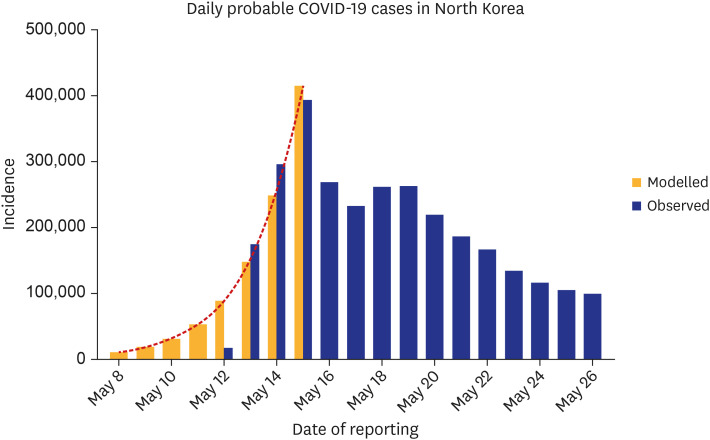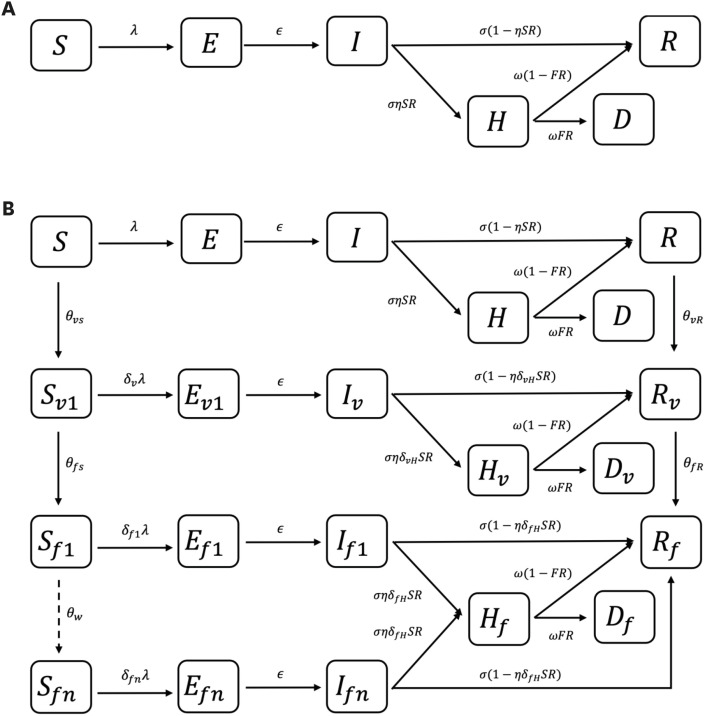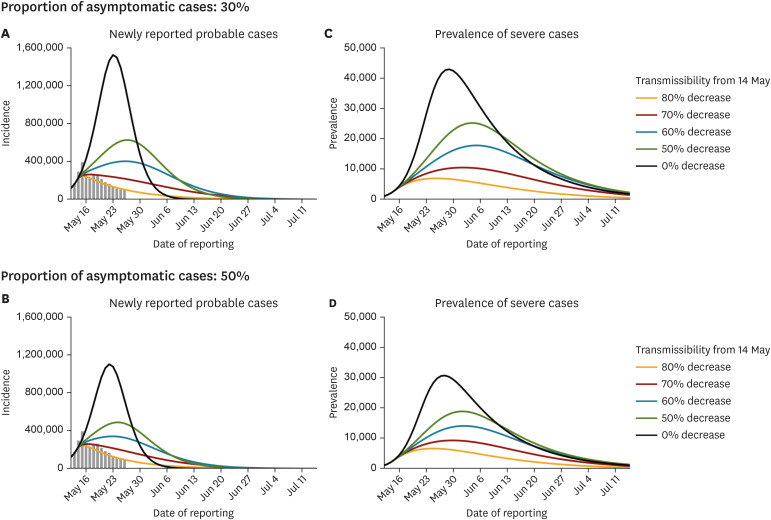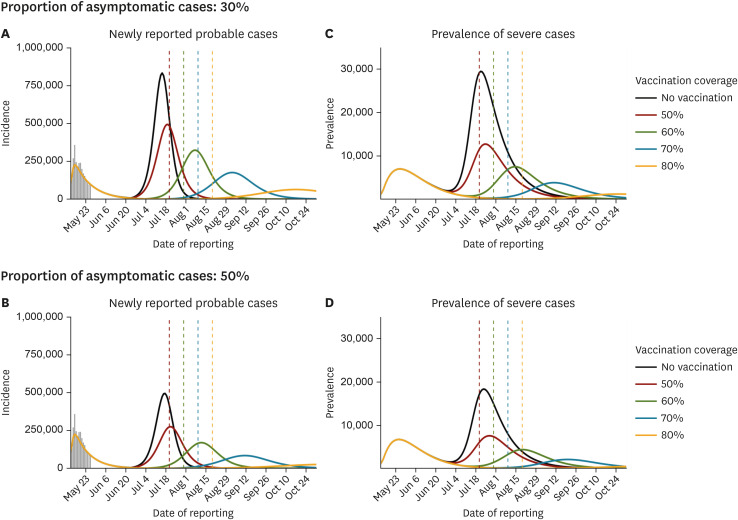J Korean Med Sci.
2022 Oct;37(41):e300. 10.3346/jkms.2022.37.e300.
The Possible Impact of Nationwide Vaccination on Outcomes of the COVID-19 Epidemic in North Korea: A Modelling Study
- Affiliations
-
- 1Kyoto University School of Public Health, Kyoto, Japan
- 2Department of Preventive Medicine, Gachon University College of Medicine, Incheon, Korea
- KMID: 2534462
- DOI: http://doi.org/10.3346/jkms.2022.37.e300
Abstract
- Background
The Democratic People’s Republic of Korea (North Korea) had successfully suppressed the coronavirus disease 2019 (COVID-19) epidemic via border closures. However, a rapid surge in incidence was reported due to the spread of the omicron variant (B.1.1.529), leading to a national emergency declaration in May 2022. Moreover, with the lack of vaccine accessibility and medical facilities, it is unclear how the disease burden may be exacerbated. Despite the limited epidemiological data, we aimed to project the COVID-19 transmissions in North Korea and quantify the potential impact of nationwide vaccination, comparing epidemiological outcomes via scenario analysis.
Methods
A discrete-time deterministic compartmental model was used. The parameters were calibrated using empirical data. Numerical simulations incorporated nationwide COVID-19 vaccination into the proposed model with various asymptomatic proportions.
Results
Our model suggested that the stringent public health and social measures (PHSMs) reduced the severe acute respiratory syndrome coronavirus 2 transmissibility by more than 80% in North Korea. Projections that explicitly incorporated vaccination indicated that nationwide vaccination would be necessary to suppress a huge resurgence in both COVID-19 cases and hospitalizations after the stringent PHSMs are eased. Moreover, vaccinating more than 80% of the population with two doses may keep the peak prevalence of hospitalizations below 1,500, averting more than 40,000 hospitalizations across all scenarios.
Conclusion
Nationwide vaccination would be essential to suppress the prevalence of COVID-19 hospitalizations in North Korea after the stringent PHSMs are lifted, especially in the case of a small asymptomatic proportion.
Keyword
Figure
Reference
-
1. Bryson WJ. Long-term health-related quality of life concerns related to the COVID-19 pandemic: a call to action. Qual Life Res. 2021; 30(3):643–645. PMID: 33073307.
Article2. Lipsitch M, Krammer F, Regev-Yochay G, Lustig Y, Balicer RD. SARS-CoV-2 breakthrough infections in vaccinated individuals: measurement, causes and impact. Nat Rev Immunol. 2022; 22(1):57–65. PMID: 34876702.3. Ritchie H, Mathieu E, Rodés-Guirao L, Appel C, Giattino C, Ortiz-Ospina E, et al. Our world in data. Coronavirus pandemic (COVID-19). 2020. Updated c2022. Accessed June 14, 2022. https://ourworldindata.org/coronavirus .4. Liu J, Liu M, Liang W. The dynamic COVID-Zero strategy in China. China CDC Wkly. 2022; 4(4):74–75. PMID: 35186372.
Article5. Cai J, Hu S, Lin Q, Ren T, Chen L. China’s ‘dynamic zero COVID-19 strategy’ will face greater challenges in the future. J Infect. 2022; 85(1):e13–e14. PMID: 35447231.
Article6. Dyer O. Covid-19: lockdowns spread in China as omicron tests “zero COVID” strategy. BMJ. 2022; 376:o859. PMID: 35361680.7. Lancet T. The Lancet. COVID-19: the next phase and beyond. Lancet. 2022; 399(10337):1753. PMID: 35526539.
Article8. Graham F. Daily briefing: ‘Out of control’ omicron threatens China. Nature. Forthcoming. 2022; DOI: 10.1038/d41586-022-00902-0.9. The Guardian. North Korea says six dead after admitting Covid outbreak for first time. Updated 2020. Accessed June 14, 2022. https://www.theguardian.com/world/2022/may/12/north-korean-state-media-confirms-first-covid-death .10. The Korean Central News Agency. Latest news. Updated 2022. Accessed June 10, 2022. http://kcna.kp/en/category/articles/q/1ee9bdb7186944f765208f34ecfb5407.kcmsf .11. Fendos J. The Diplomat. What comes next in North Korea’s battle with omicron? Updated 2022. Accessed June 14, 2022. https://thediplomat.com/2022/05/what-comes-next-in-north-koreas-battle-with-omicron/ .12. Kim DJ, Kim AI. Global health diplomacy and North Korea in the COVID-19 era. Int Aff. 2022; 98(3):915–932.13. BBC NEWS. Covid in North Korea: no response to US vaccine offer. Updated 2022. Accessed June 14, 2022. https://www.bbc.com/news/world-asia-61533715 .14. The Korean Central News Agency. Guide for treating COVID-19 issued in DPRK. Updated 2022. Accessed June 10, 2022. http://kcna.kp/en/article/q/64e900f5bd0353837ca02d7babcce3ad5ebbe8f6913f046e47e6def08167cc46ce107dee5691fcb37707933c16cbc55c.kcmsf .15. Goodkind D, West L. The North Korean famine and its demographic impact. Popul Dev Rev. 2001; 27(2):219–238. PMID: 18581641.16. Jung SM, Akhmetzhanov AR, Hayashi K, Linton NM, Yang Y, Yuan B, et al. Real-time estimation of the risk of death from novel coronavirus (COVID-19) infection: Inference using exported cases. J Clin Med. 2020; 9(2):523.17. Backer JA, Klinkenberg D, Wallinga J. Incubation period of 2019 novel coronavirus (2019-nCoV) infections among travellers from Wuhan, China, 20-28 January 2020. Euro Surveill. 2020; 25(5):2000062.18. The Korean Central News Agency. Maximum emergency epidemic prevention system comes into force, state emergency measures taken. Updated 2022. Accessed June 10, 2022. http://kcna.kp/en/article/q/64e900f5bd0353837ca02d7babcce3ad55523fb181fd38908cb61bdcf4821ff6e90b7d9d2886bc48b3cc61aad7ed43cc.kcmsf .19. Garrett N, Tapley A, Andriesen J, Seocharan I, Fisher LH, Bunts L, et al. High asymptomatic carriage with the omicron variant in South Africa. Clin Infect Dis. 2022; 75(1):e289–e292. PMID: 35353885.20. Buitrago-Garcia D, Ipekci AM, Heron L, Imeri H, Araujo-Chaveron L, Arevalo-Rodriguez I, et al. Occurrence and transmission potential of asymptomatic and presymptomatic SARS-CoV-2 infections: update of a living systematic review and meta-analysis. PLoS Med. 2022; 19(5):e1003987. PMID: 35617363.21. U.S. Food and Drug Administration. FDA statement on following the authorized dosing schedules for COVID-19 vaccines. Updated 2021. Accessed June 10, 2022. https://www.fda.gov/news-events/press-announcements/fda-statement-following-authorized-dosing-schedules-covid-19-vaccines .22. Andrews N, Stowe J, Kirsebom F, Toffa S, Rickeard T, Gallagher E, et al. Covid-19 vaccine effectiveness against the omicron (B.1.1.529) variant. N Engl J Med. 2022; 386(16):1532–1546. PMID: 35249272.23. Lee YH, Yoon SJ, Kim YA, Yeom JW, Oh IH. Overview of the burden of diseases in North Korea. J Prev Med Public Health. 2013; 46(3):111–117. PMID: 23766868.24. Tindale LC, Stockdale JE, Coombe M, Garlock ES, Lau WY, Saraswat M, et al. Evidence for transmission of COVID-19 prior to symptom onset. eLife. 2020; 9:e57149. PMID: 32568070.25. Nguyen T, Adnan M, Nguyen BP, de Ligt J, Geoghegan JL, Dean R, et al. COVID-19 vaccine strategies for Aotearoa New Zealand: a mathematical modelling study. Lancet Reg Health West Pac. 2021; 15:100256. PMID: 34426804.26. Kirsebom FC, Andrews N, Stowe J, Toffa S, Sachdeva R, Gallagher E, et al. COVID-19 vaccine effectiveness against the omicron (BA.2) variant in England. Lancet Infect Dis. 2022; 22(7):931–933. PMID: 35623379.27. Keeling MJ, Hill EM, Gorsich EE, Penman B, Guyver-Fletcher G, Holmes A, et al. Predictions of COVID-19 dynamics in the UK: short-term forecasting and analysis of potential exit strategies. PLOS Comput Biol. 2021; 17(1):e1008619. PMID: 33481773.
Article28. Moore S, Hill EM, Tildesley MJ, Dyson L, Keeling MJ. Vaccination and non-pharmaceutical interventions for COVID-19: a mathematical modelling study. Lancet Infect Dis. 2021; 21(6):793–802. PMID: 33743847.29. Gozzi N, Chinazzi M, Davis JT, Mu K, Piontti AP, Vespignani A, et al. Preliminary modeling estimates of the relative transmissibility and immune escape of the omicron SARS-CoV-2 variant of concern in South Africa. medRxiv. January. 5. 2022; DOI: 10.1101/2022.01.04.22268721.30. Wagner CE, Saad-Roy CM, Morris SE, Baker RE, Mina MJ, Farrar J, et al. Vaccine nationalism and the dynamics and control of SARS-CoV-2. Science. 2021; 373(6562):eabj7364. PMID: 34404735.31. Lancet T. The Lancet. Access to COVID-19 vaccines: looking beyond COVAX. Lancet. 2021; 397(10278):941. PMID: 33714374.32. Jo Y, Kim SB, Radnaabaatar M, Huh K, Yoo JH, Peck KR, et al. Model-based cost-effectiveness analysis of oral antivirals against SARS-CoV-2 in Korea. Epidemiol Health. 2022; 44:e2022034. PMID: 35381167.33. Marks F, Nyambat B, Xu ZY, von Kalckreuth V, Kilgore PE, Seo HJ, et al. Vaccine introduction in the Democratic People’s Republic of Korea. Vaccine. 2015; 33(20):2297–2300. PMID: 25769209.34. Jung SM, Hayashi K, Kayano T, Nishiura H. Response to COVID-19 during the Tokyo Olympic Games: did we properly assess the risk? Epidemics. 2022; 40:100618. PMID: 35908478.
- Full Text Links
- Actions
-
Cited
- CITED
-
- Close
- Share
- Similar articles
-
- Dynamics of the COVID-19 epidemic in the post-vaccination period in Korea: a rapid assessment
- Impact of solid organ transplantation on the effectiveness of COVID-19 vaccination in hospitalized patients with COVID-19: a propensity score-matched cohort study
- COVID-19 infection and severe clinical outcomes in patients with kidney disease by vaccination status: a nationwide cohort study in Korea
- Association between face covering policies and the incidence of coronavirus disease 2019 in European countries
- Impact of the COVID-19 Pandemic on Esophagogastroduodenoscopy and Gastric Cancer Claims in South Korea: A Nationwide, Population-Based Study






